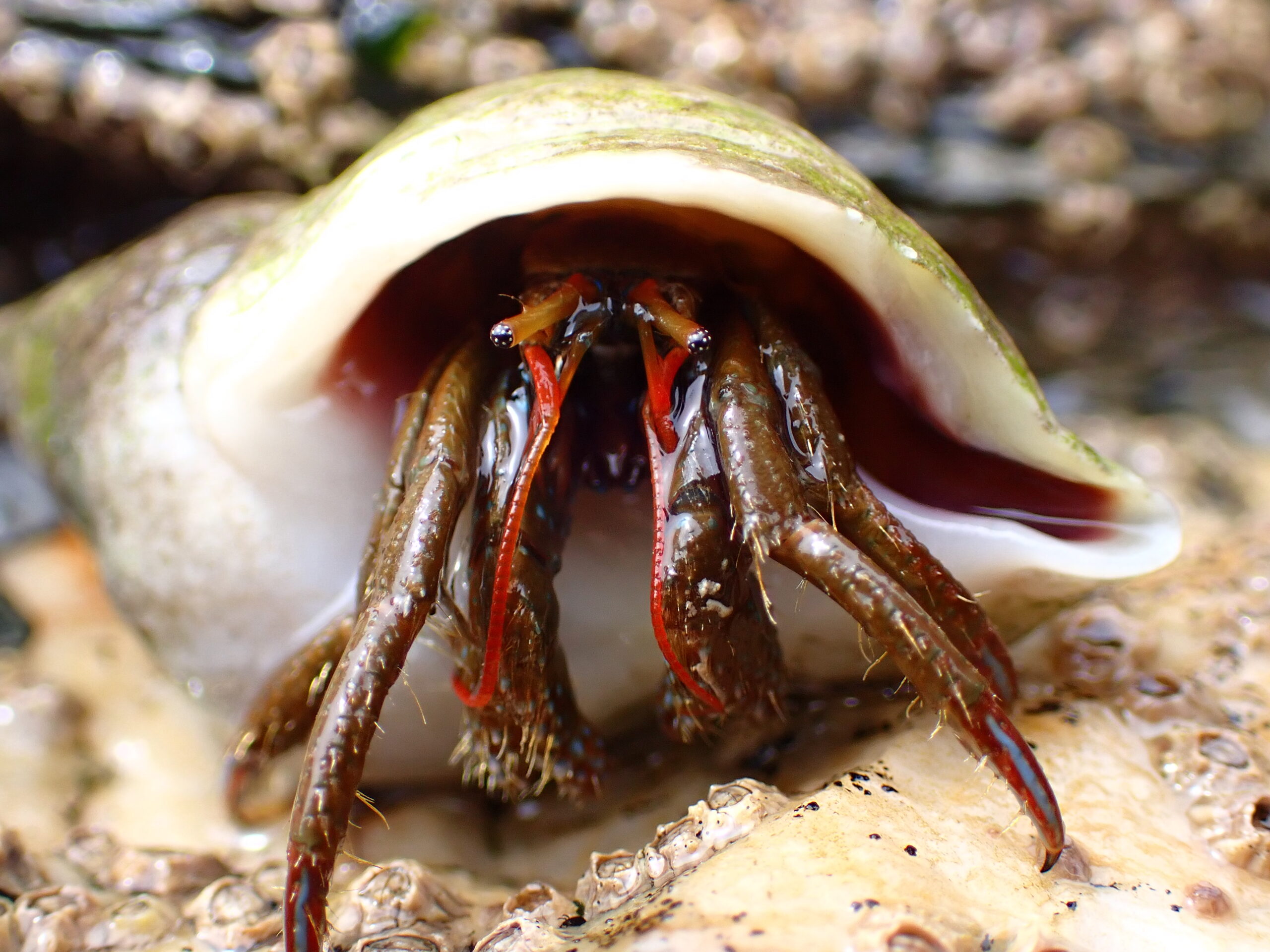Plymouth Sound National Marine Park is a treasure trove of marine biodiversity just waiting to be discovered. Rock pools are dotted all around our coastlines that teem with fascinating inhabitants. Whether you’re a seasoned marine enthusiast or a curious newcomer, exploring these tidal pools offers a unique glimpse into a world filled with colourful creatures and intricate ecosystems.
In this blog, we’ll dive into the diverse species that call these rock pools home, from the resilient anemones to the elusive crabs. We’ll also share tips on how to safely explore these fascinating environments, ensuring that we protect and preserve their delicate balance for future generations. So grab your wellies and a sense of adventure as we embark on a journey through the vibrant life of Plymouth Sound’s rock pools.
Edible Crab
The edible crab, known scientifically as Cancer pagurus, is a fascinating marine creature found along the coasts of Europe and North America. These crabs can grow up to 10 inches wide and can live for over 30 years! They have a distinctive hard shell that can range in color from greenish-brown to bright orange. Edible crabs are also known for their impressive claw strength, which they use to crack open mollusks and other prey. Interestingly, they can regenerate lost limbs over time, making them quite resilient. Additionally, these crabs play a significant role in their ecosystems, helping to control the populations of their prey and serving as an important food source for various predators, including seabirds and larger fish.
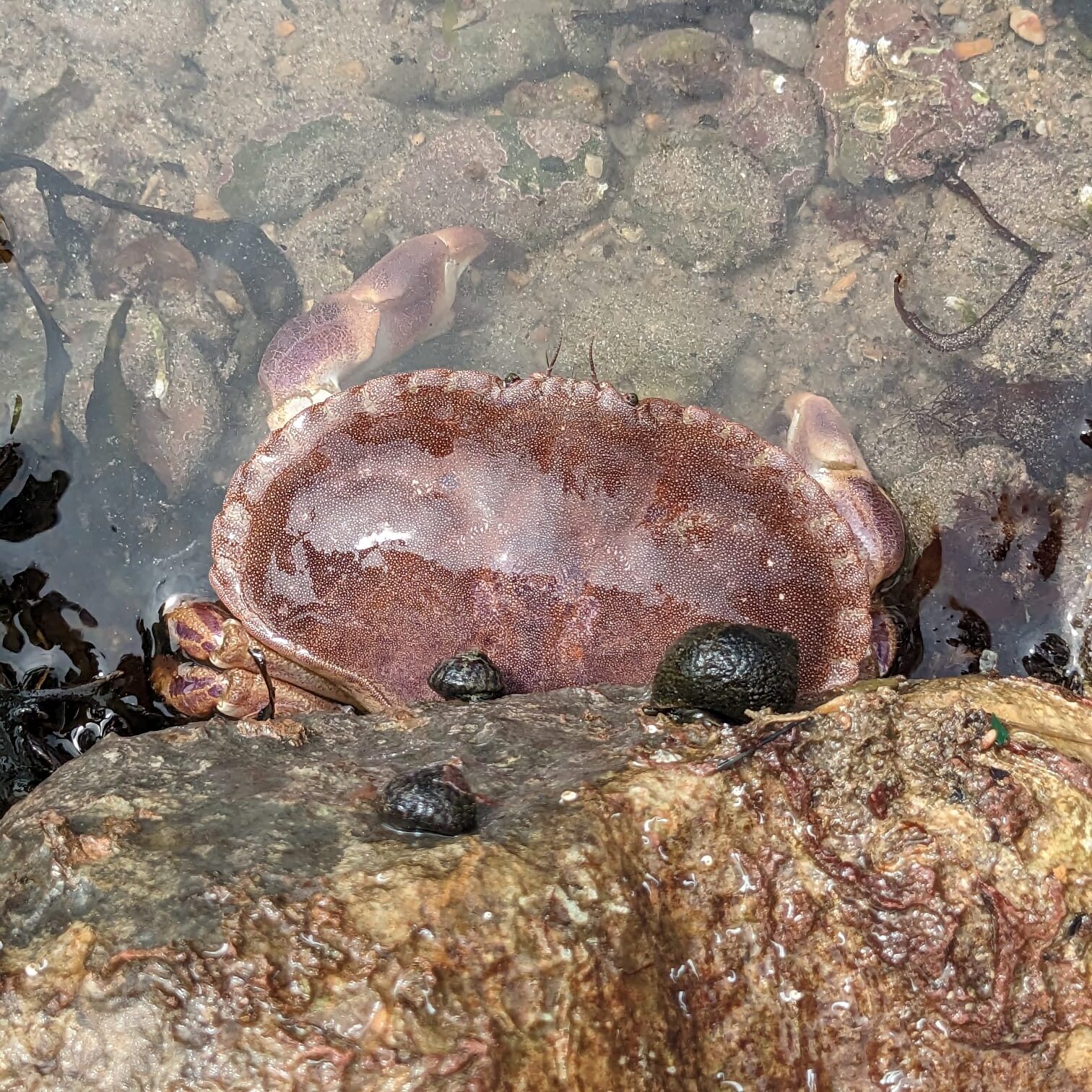
Candy-striped Flatform
The candy-striped flatworm, Pseudobiceros hancockanus, is a stunning sight in Plymouth Sound, known for its eye-catching bands of pink and white that resemble a candy cane. These flatworms are typically found in shallow waters, often hiding under rocks. Reaching lengths of up to 10 inches, they have a fascinating ability to regenerate lost body parts, including their heads, making them incredibly resilient. In Plymouth Sound, they contribute to the vibrant marine biodiversity, feeding primarily on small invertebrates. Notably, these flatworms engage in unique mating behaviours, where they sometimes “fence” with their dual reproductive organs—a quirky display of competition for fertilisation. Despite their beauty, they produce toxins to ward off predators, making them both a marvel and a mystery in the underwater world
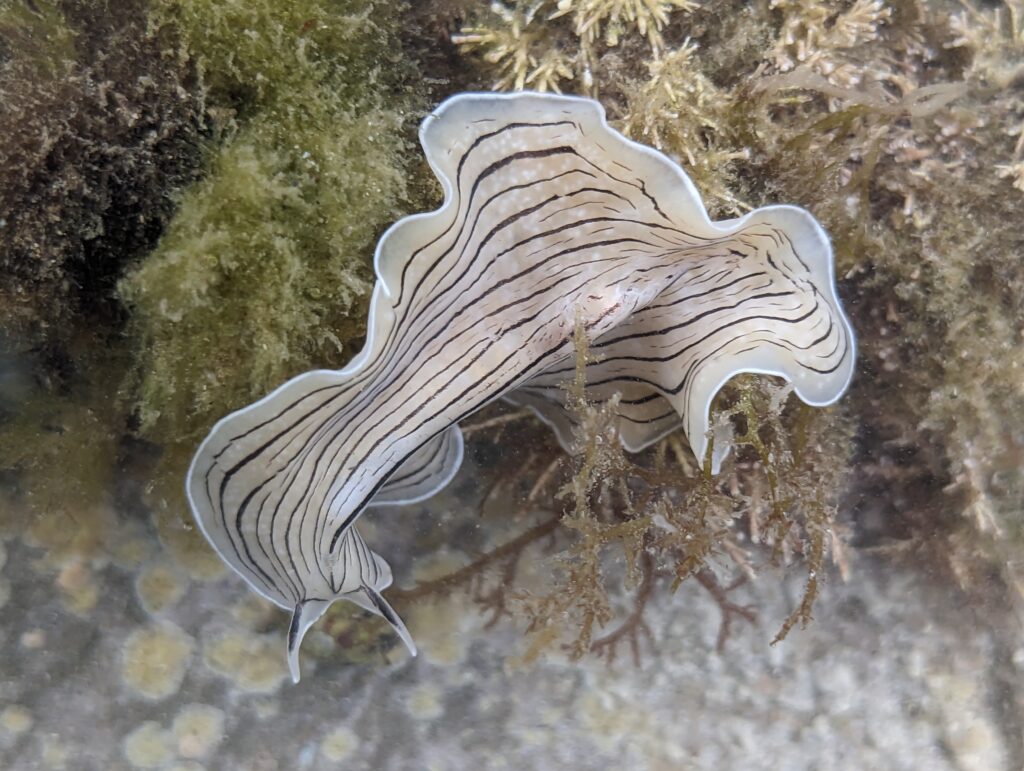
Common Prawn
The common prawn, scientifically known as Palaemon serratus, is a fascinating marine crustacean widely found in coastal waters across Europe and the North Atlantic. These lively little creatures can grow up to 7 inches long and are easily recognised by their long antennae and distinctive reddish-brown colouring, often adorned with lighter stripes. Common prawns play a crucial role in the marine food web, serving as a vital food source for fish, birds, and other predators. They are also known for their incredible agility, using powerful tails to propel themselves backward quickly when threatened. These prawns undergo a fascinating life cycle, starting as tiny larvae that drift in the open ocean before settling into estuaries and coastal habitats. Additionally, they are a popular delicacy in many cuisines, making them an important catch for both commercial and recreational fishermen.
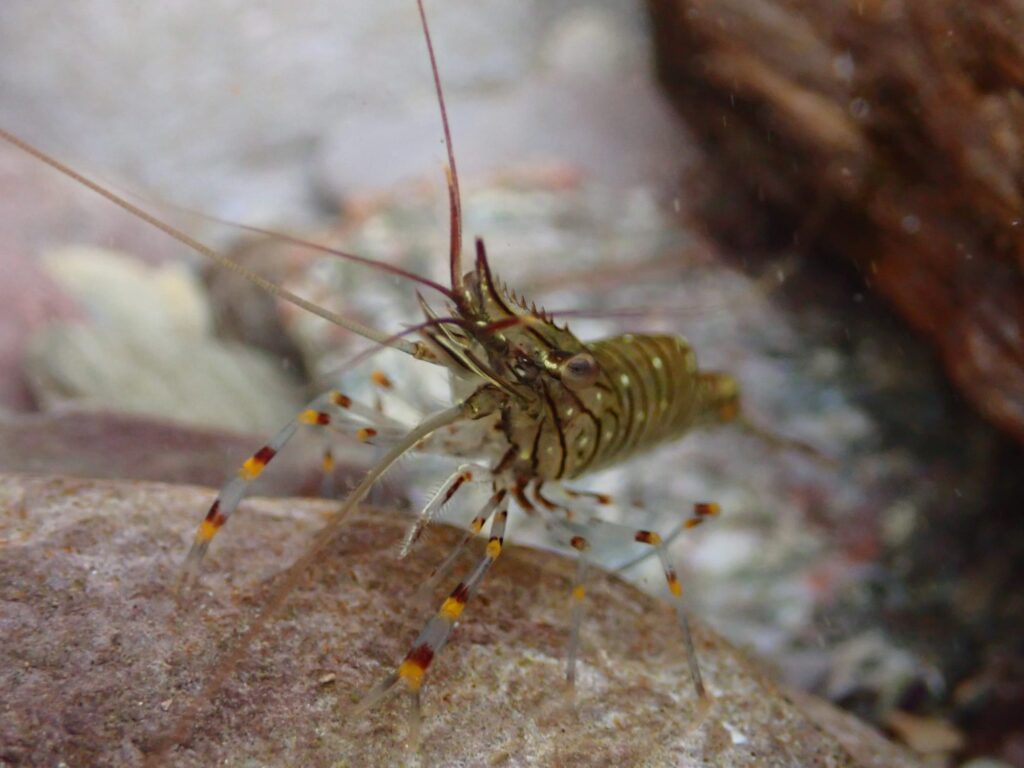
Flat Periwinkle
The flat periwinkle, scientifically known as Littorina obtusata, is a charming marine snail commonly found in the intertidal zones of rocky shores across Europe and North America. This small mollusk typically measures about 1 to 2 inches in length and is easily identified by its distinctive, flat, spiral shell, which often features a range of colors from brown to green. Flat periwinkles are known for their adaptability, able to thrive in both freshwater and saltwater environments, and they graze on algae and diatoms, playing an important role in their ecosystem. They are also fascinating in their reproductive behavior; these snails are simultaneous hermaphrodites, meaning they possess both male and female reproductive organs, allowing for flexible mating strategies. Additionally, flat periwinkles can often be seen clinging to rocks during low tide, where they use their strong foot to hold on tightly and avoid being washed away by waves!
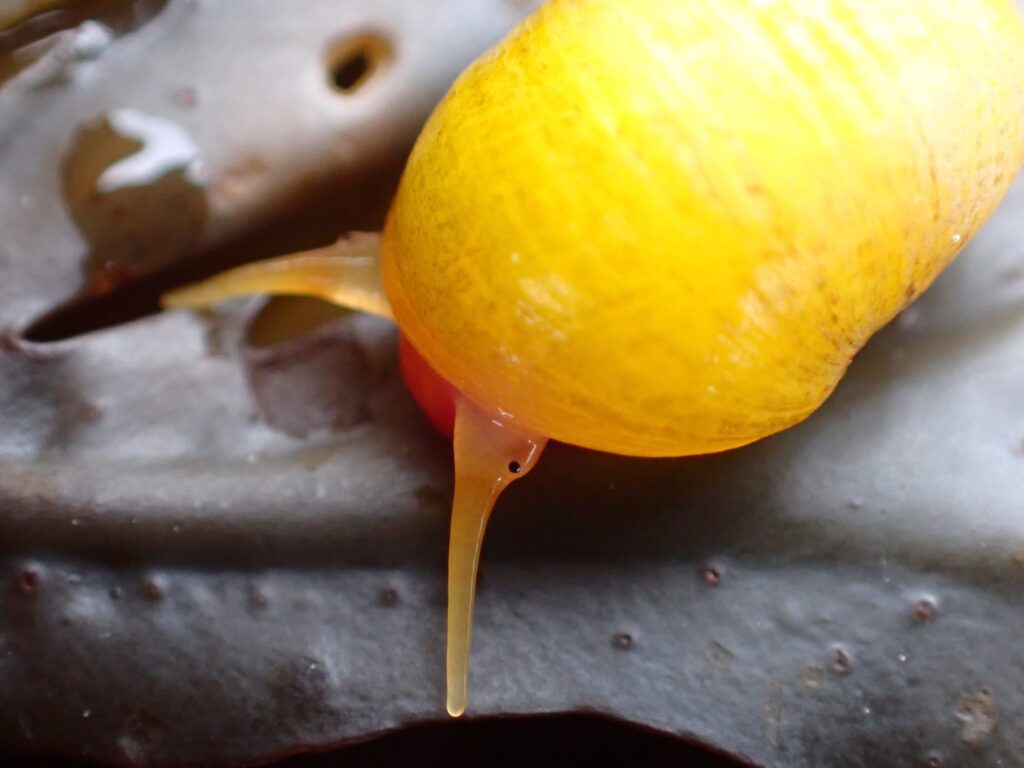
Green Sea Urchin
Psammechinus miliaris, commonly known as the green sea urchin or the sand urchin, is a fascinating echinoderm typically found along the rocky shores of Europe and the northern Atlantic. These small, globular sea urchins can reach up to 3 inches in diameter and are characterised by their vibrant colours, ranging from green to purple, and their dense covering of short spines. What makes P. miliaris particularly interesting is its ability to thrive in a variety of habitats, from shallow tidal pools to deeper waters. They play a vital role in their ecosystem by grazing on algae and helping to maintain the balance of marine flora. Green sea urchins are also known for their unique reproductive behaviour; they spawn by releasing eggs and sperm into the water column, which leads to the development of free-swimming larvae. Additionally, their gonads are considered a delicacy in various cuisines, particularly in Mediterranean and Japanese dishes, making them a sought-after catch for seafood lovers!
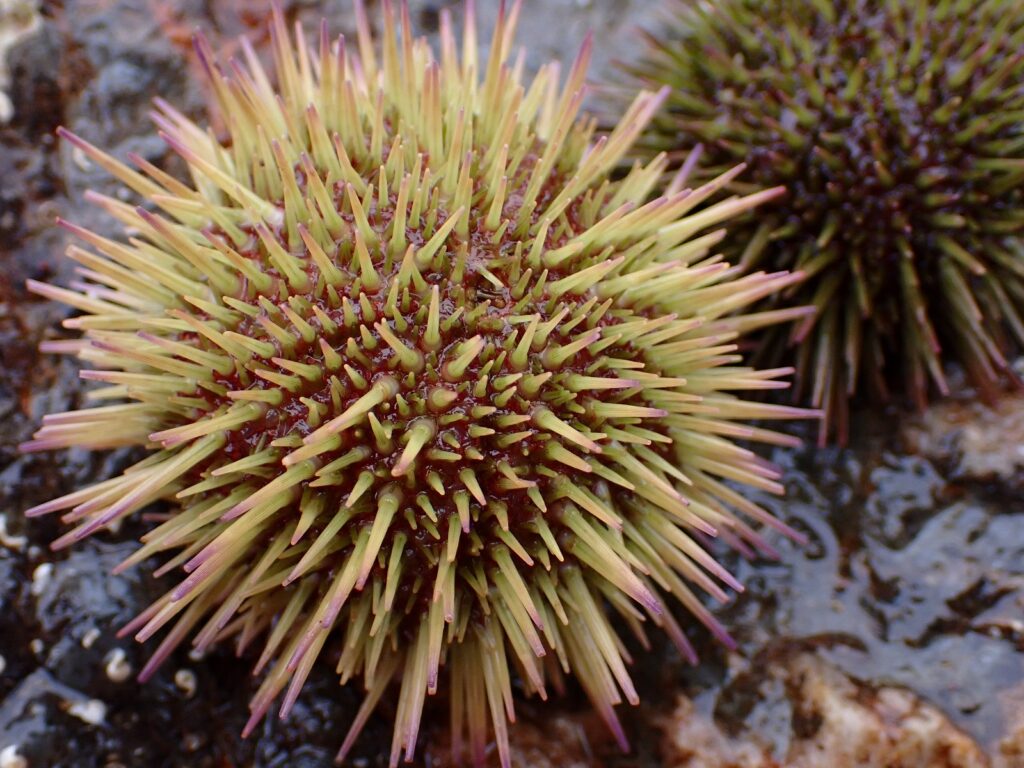
Grey Sea Slug
The grey sea slug, scientifically known as Aeolidia papillosa, is a captivating marine gastropod found along the coasts of the North Atlantic, including regions like the British Isles and the eastern United States. Typically measuring around 3 to 5 inches in length, this sea slug is easily recognised by its soft, elongated body adorned with clusters of cerata—finger-like projections that not only enhance its appearance but also serve vital functions in respiration and defence. One of the most intriguing aspects of A. papillosa is its diet; it primarily feeds on anemones and can incorporate the stinging cells from its prey into its own body for protection against predators. Additionally, grey sea slugs have a unique ability to regenerate lost body parts, making them incredibly resilient. They also reproduce through a fascinating process called copulation, where two slugs ‘get together’, and they can lay hundreds of eggs in colourful, spiral masses, contributing to the biodiversity of marine ecosystems. Their striking appearance and interesting adaptations make them a favourite among divers and marine enthusiasts!
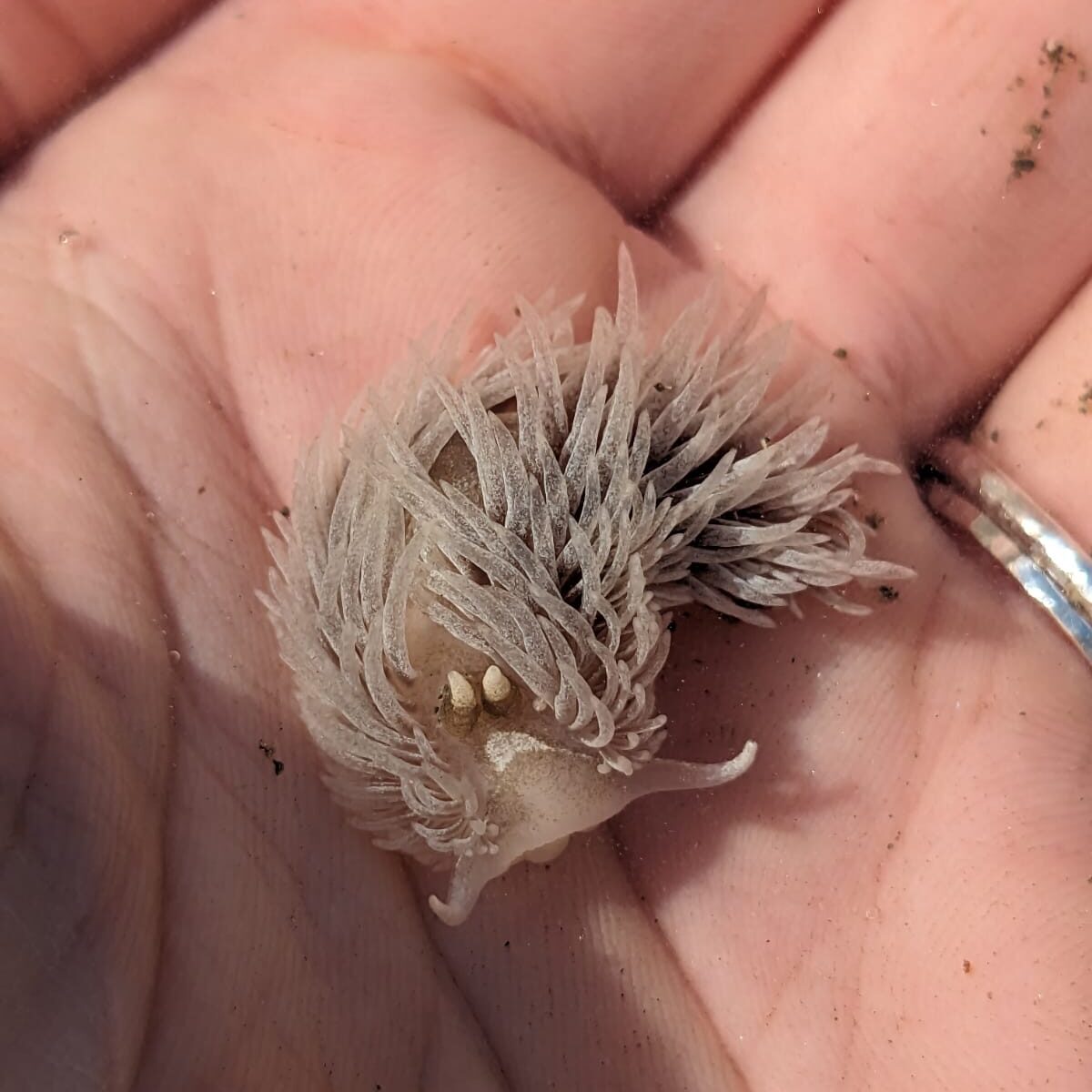
Porcelain Crab
Porcellana platycheles, commonly known as the porcelain crab, is a fascinating marine crustacean found in the coastal waters of the North Atlantic. Typically measuring around 2 inches across, this small crab is easily identified by its smooth, flat body and distinctive white to yellow coloration, often adorned with reddish-brown markings. One of the most interesting features of P. platycheles is its remarkable adaptability; it often lives in symbiotic relationships with sea anemones, which provide shelter and protection while the crab feeds on plankton and detritus in the surrounding water. Unlike many other crabs, smooth porcelain crabs have a unique method of locomotion, using their broad, flattened bodies to move gracefully through the water. They also have the ability to regenerate lost limbs, making them quite resilient to predation. Additionally, Porcellana platycheles has been noted for its social behavior, often found in groups, which adds to the dynamic of the marine ecosystem it inhabits. Their charming appearance and intriguing lifestyle make them a delightful subject for marine enthusiasts!
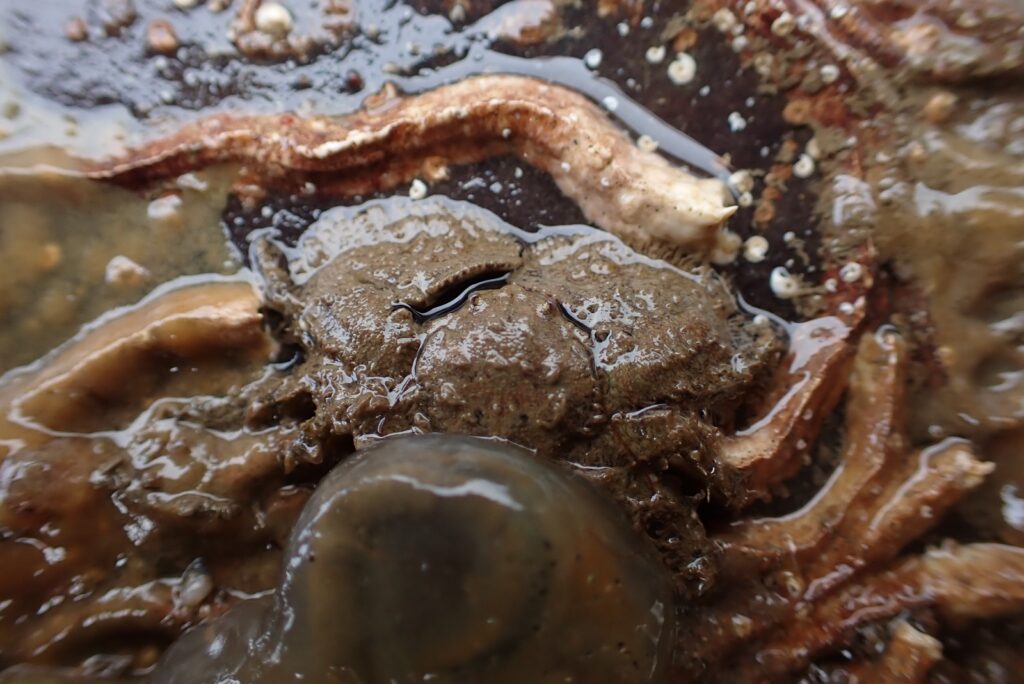
The Long-spined Sea Scorpion
Scientifically known as Taurulus bubalis, is an intriguing fish known for its striking appearance and impressive adaptations. Found in various marine environments worldwide, especially in shallow coastal waters, these fish are recognisable by their flattened bodies, elongated snouts, and spiny fins, which give them a scorpion-like look. One of the most fascinating features of sea scorpions is their incredible camouflage; they often blend seamlessly into their surroundings, such as rocky reefs or sandy bottoms, allowing them to ambush prey effectively. They are primarily carnivorous, feeding on smaller fish and crustaceans, and they possess venomous spines on their dorsal fins that serve as a defence mechanism against predators. Some species of sea scorpion can also change colour to match their environment more closely! Additionally, sea scorpions have a unique method of locomotion, using their pectoral fins to “walk” along the seabed, making them a captivating sight for divers and marine enthusiasts. With their combination of beauty, adaptability, and intriguing behaviours, sea scorpions are truly remarkable inhabitants of the National Marine Park.
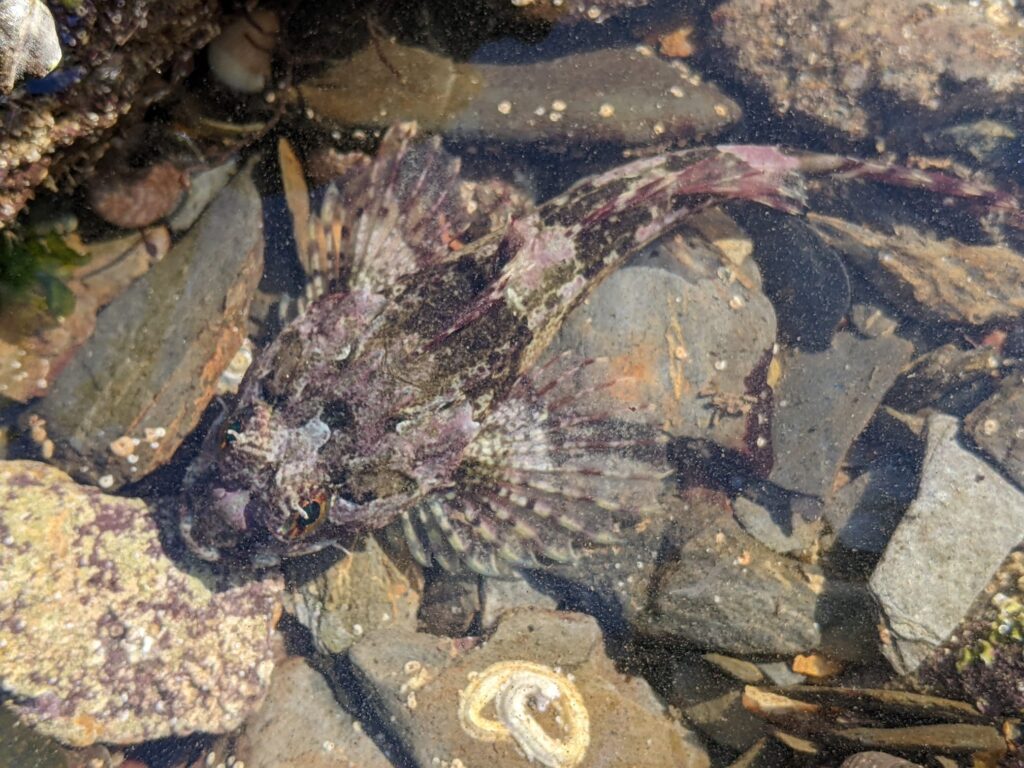
Snakelocks Anemone
The snakelocks anemone, scientifically known as Anemonia viridis, is a captivating sea creature found along the rocky shores of Europe and the Mediterranean. Known for its vibrant, curly tentacles that resemble snake locks, this anemone can display a range of colours, including bright green, pink, and purple, making it a striking addition to marine environments. Like all anemones, snakelocks have tiny barbs on their tentacles that, when touched, fires them into their prey. Generally, our skin is too thick for these harpoons but it’s still important not to touch for their safety. Their spines can also aggravate our eyes if we rub them once engaging with an anemone. They are also notable for their ability to reproduce both sexually and asexually; they can release eggs and sperm into the water column or clone themselves by budding. Snakelocks anemones play an important role in their ecosystems, providing habitat for various marine species and contributing to the biodiversity of their environments.
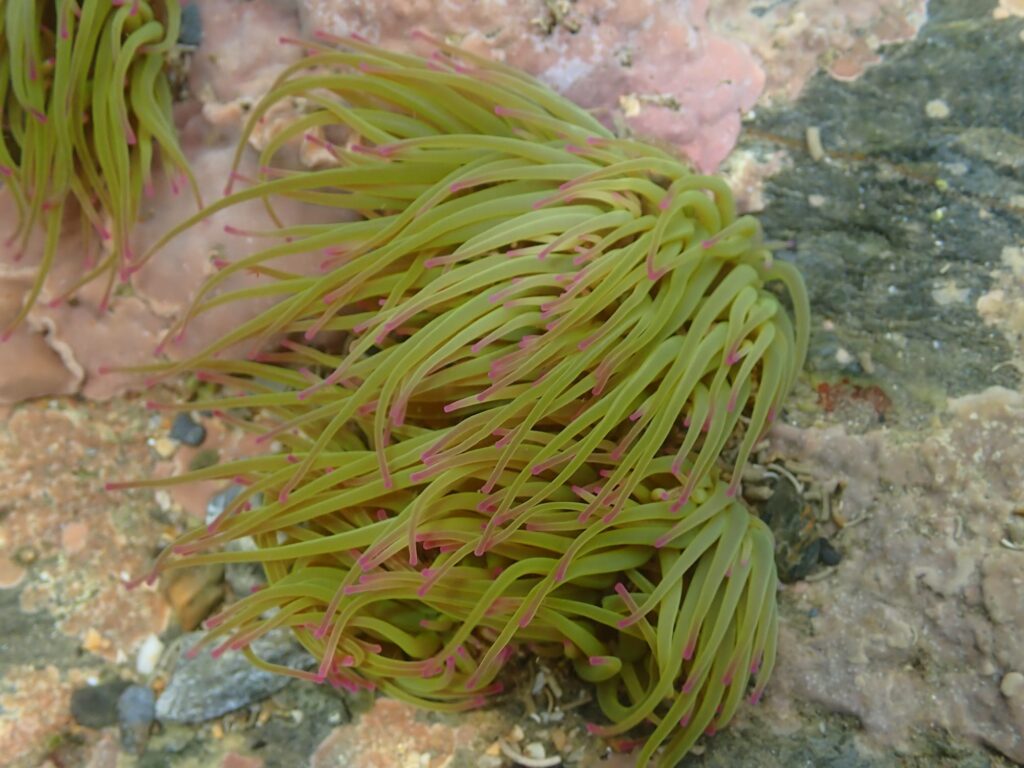
Olive Squat Lobster
Galathea squamifera, commonly known as the olive squat lobster, is a fascinating marine crustacean found in the waters of the North Atlantic and UK waters, particularly around rocky substrates and coral reefs. This small lobster typically reaches lengths of about 2 to 4 inches and is easily recognised by its distinctive flattened body and spiny, textured carapace, which provides both protection and camouflage among the rocky seafloor. It primarily scavenges for food, consuming detritus, algae, and small invertebrates, playing a crucial role in the ecosystem by helping to recycle nutrients. Additionally, these squat lobsters are known for their social behaviour, often found in small groups or under ledges, where they use their powerful pincers to interact and communicate with one another. Like crabs, they also have the ability to regenerate lost limbs.
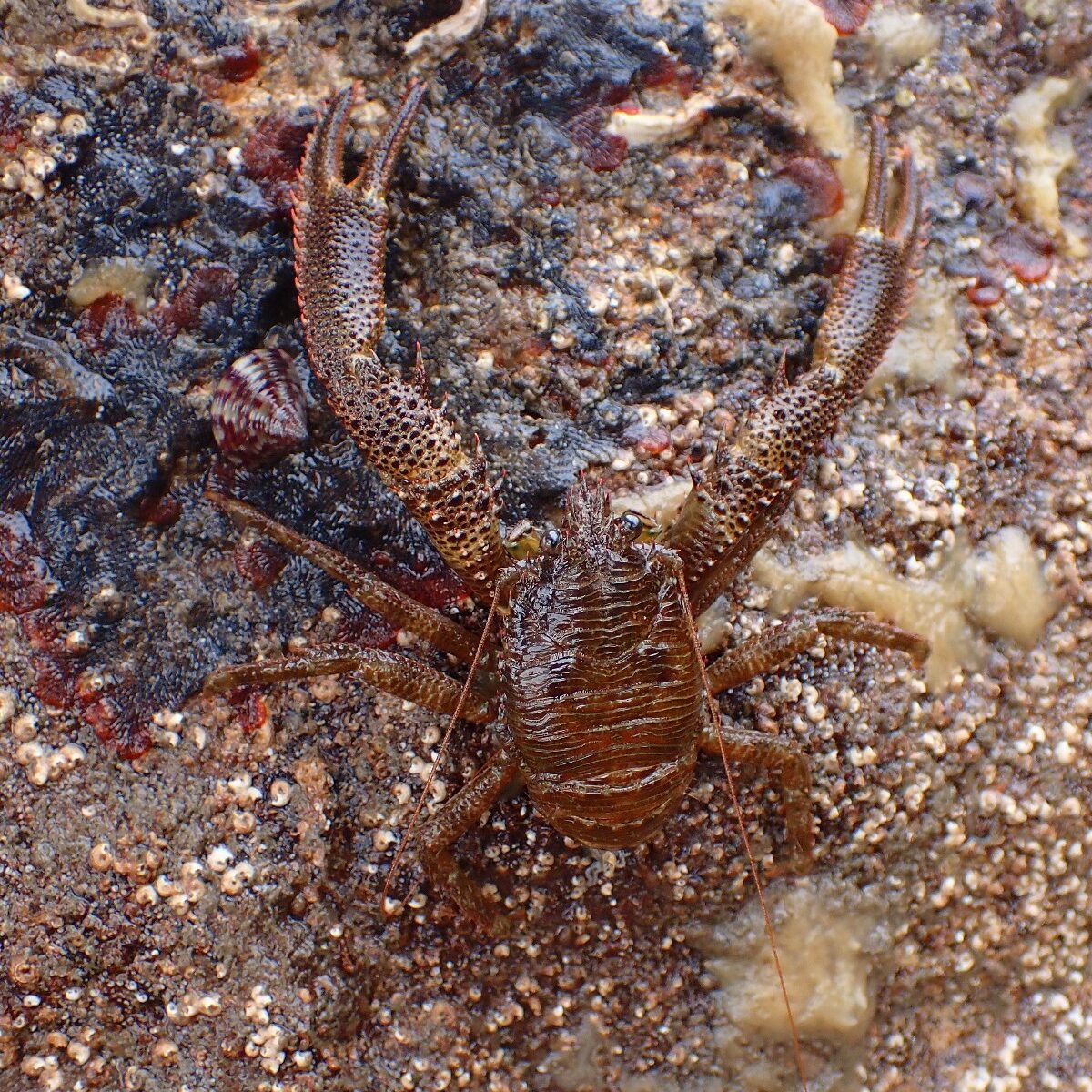
Strawberry Anemone
The strawberry anemone, scientifically known as Actinia fragacea, is a vibrant marine creature often found along the rocky shores of the North Atlantic and in the Mediterranean Sea. Known for its stunning appearance, this anemone features a bulbous body adorned with numerous colourful, tentacle-like projections that can range from bright red to orange, resembling ripe strawberries! One fascinating aspect of the strawberry anemone is its ability to thrive in a variety of environments, from tidal pools to deeper waters, making it a resilient inhabitant of diverse marine ecosystems. These anemones are primarily carnivorous, using their stinging tentacles to capture small fish and plankton for nourishment.
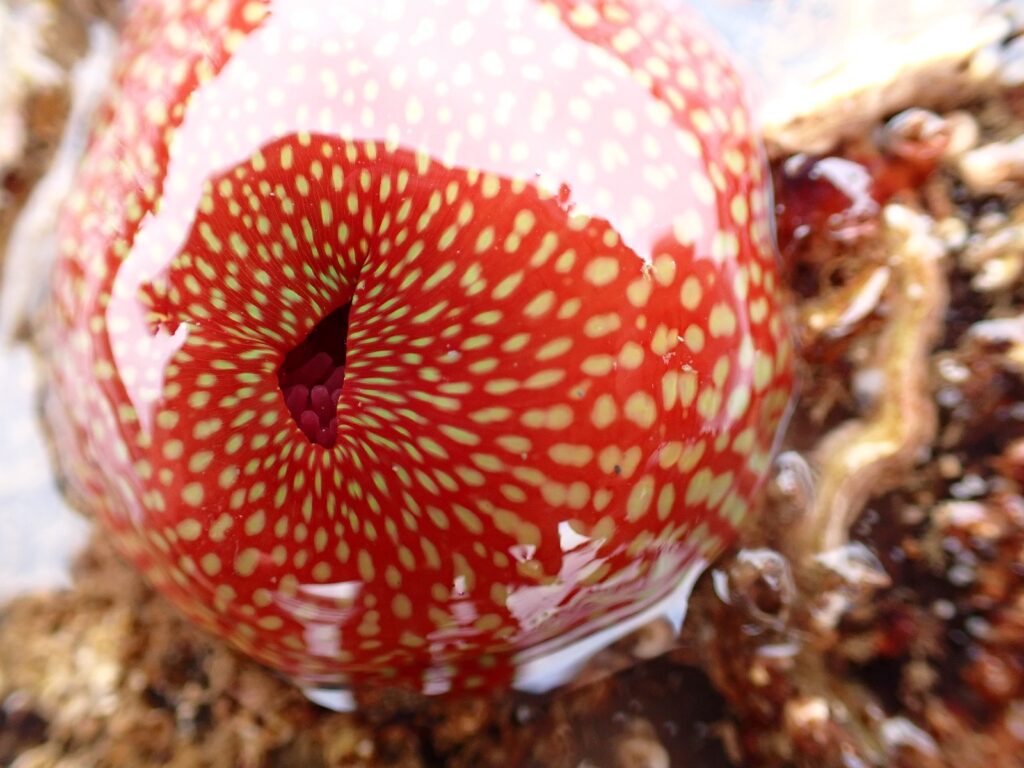
St. Piran’s Hermit Crab
St. Piran’s hermit crab, scientifically known as Clibanarius erythropus, is a captivating crustacean commonly found along the rocky shores of the British Isles and parts of the North Atlantic. These small hermit crabs are notable for their unique habit of residing in discarded shells, which they change as they grow, making them quite resourceful. St. Piran’s hermit crabs can often be seen carrying a variety of shells, ranging from whelk to periwinkle shells, providing both protection and a home. One of the most fascinating aspects of their behaviour is their social interactions; they are known to engage in shell exchanges and will even compete for the best shells with other hermit crabs. They primarily feed on detritus and algae, using their pincers to scavenge for food. Additionally, these crabs have a unique adaptation that allows them to survive in tidal pools where oxygen levels can fluctuate, making them incredibly resilient. With their charming appearance and bumbling shyness, St. Piran’s hermit crabs are a delightful part of the marine ecosystem!
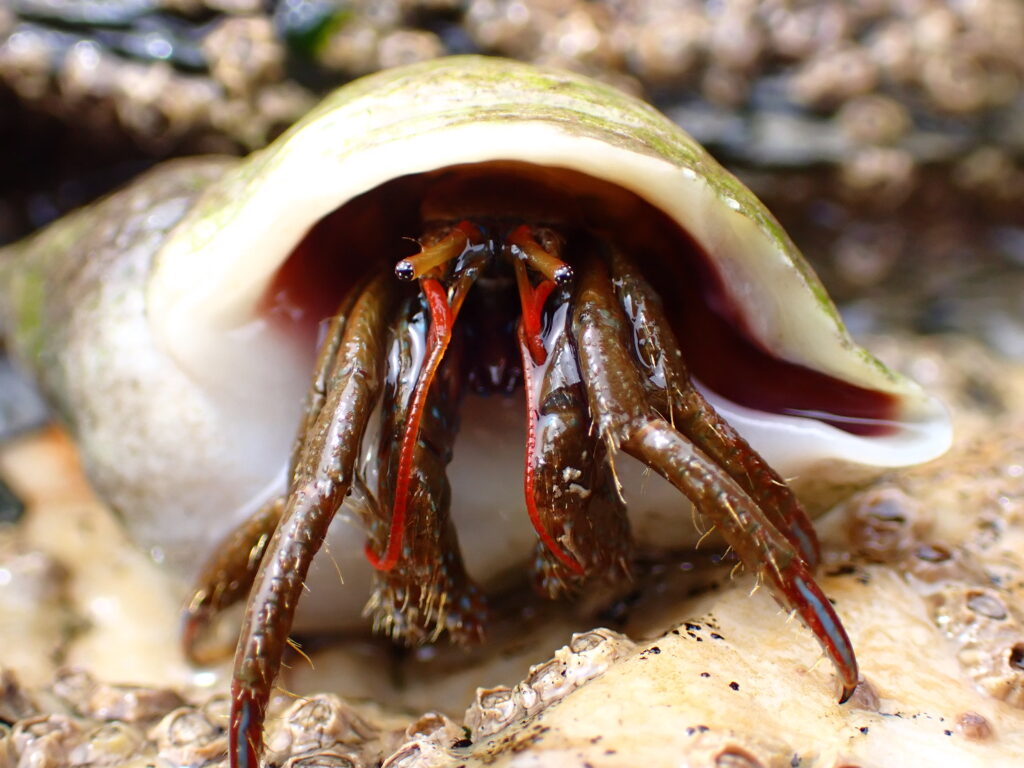
Rock Pooling Tips
We encourage everyone to give rock pooling a go, here’s some tips to help you and the wildlife out on your coastal explorations:
Here’s a handy list of tips for rock pooling that covers safety, essential equipment, and wildlife conservation:
Safety Tips
- Wear Appropriate Footwear: Use sturdy shoes or water boots with good grip to avoid slipping on wet rocks.
- Check Tide Times: Always be aware of tide schedules to prevent getting stranded by rising water levels.
- Be Cautious of Waves: Stay alert for sudden waves or swells, especially in exposed areas.
- Avoid Rocky Areas Alone: Always go rock pooling with a buddy or a group for safety.
- Keep an Eye on Children: If kids are present, supervise them closely to ensure they stay safe and do not wander off.
Essential Equipment
- Bucket or Container: Use a container to temporarily hold any creatures you want to observe, ensuring it has holes for aeration.
- Spoon or Net: A small net or spoon can help gently scoop up animals without harming them.
- Field Guide: Bring a marine life identification book or app to learn about the species you encounter.
- Camera: Capture your discoveries, but avoid using flash as it can disturb wildlife.
Wildlife Conservation Tips
- Handle with Care: If you do pick any animals up (we advise against it!) always handle them gently to reduce their stress and well-being.
- Return Animals to Their Habitat: Put any creatures you observe back in the same spot you found them, ensuring they are returned safely to their habitat. If you turned a rock over, always turn it back. How would you feel if someone flipped your home upside down?
- Do Not Collect: Avoid taking any animals or shells home; this helps maintain local biodiversity.
- Respect Marine Life: Observe from a distance, and do not disturb nesting sites or hiding spots.
- Leave No Trace: Take all your litter with you and leave the area as you found it to protect the habitat for wildlife.
By following these tips, you can enjoy rock pooling while ensuring safety and contributing to the conservation of marine life!


